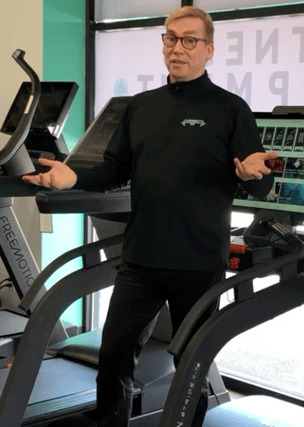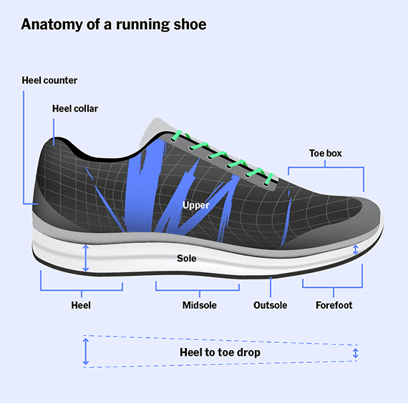I've been doing this for over 25 years now. And I've been on all sides of the fitness equipment world. I've designed equipment for over a dozen manufacturers, I've been in leadership and Executive roles for dealers and for manufacturers, and I've dealt with tens of thousands of clients and their experience with the equipment. So I have a relatively unique set of knowledge in this sphere.
And frankly, I've had a service department, or multiple service departments, fixing treadmills that whole time. And that 'under the hood' knowledge can age you.
And I've done versions of buying guides before, I've helped do ratings back when there really *were* ratings of equipment (get off my lawn...), before they all became fake affiliate sites. And I've been the deciding force for a number of companies, large and small, as to what brands they're going to carry and support.

I'm going to try to give you a little checklist for purchasing a treadmill for home, based on all this fun knowledge I've gained. A real checklist, based on physics and facts.
We're not going to mention any brands or models, so you can trust it. We are not one of the fake affiliate ratings scams. This is just going to be straight facts, a checklist for you to use.
We're not going to mention any brands or models, so you can trust it. We are not one of the fake affiliate ratings scams. This is just going to be straight facts, a checklist for you to use.
The treadmill is by far the most popular and largest segment in the fitness equipment world. Which is why there is so much fake information and fake ratings out there. Treadmills can be a big investment, and there are a lot of bad actors. And by the way, somewhat different rules apply when purchasing a treadmill for a facility, this is a residential checklist.
1. The first rule of purchasing a treadmill is stability.
Weight of treadmill versus weight of user equals stability. That ratio has a lot to do with how your use will affect the machine. A 150 lb walker puts a lot less stress on a treadmill than a 250 lb runner, and a lot of it just comes down to the weight of the unit versus the weight of the user.
Weight of treadmill versus weight of user equals stability. That ratio has a lot to do with how your use will affect the machine. A 150 lb walker puts a lot less stress on a treadmill than a 250 lb runner, and a lot of it just comes down to the weight of the unit versus the weight of the user.
Also, folding treadmills are less durable because of the same factor. They don't have a contiguous frame, so their stability is a little more compromised from the beginning. There is a reason why there's no such thing as a folding commercial treadmill or even a high-end folding treadmill, but almost all the lower-end machines fold.
Also, the "Maximum Weight Rating" of the unit has very little to do with this. That rated weight limit is not what you think it is. When a treadmill says that it has a 300 lb rated maximum, all they're saying is that if a 300 lb person gets on the treadmill, it will run. It doesn't mean it's not going to dramatically affect the lifespan of the machine, which is what you really want to know.


As a rule of thumb, the users should never outweigh your treadmill, and if you are going to run on the treadmill the treadmill should outweigh you by at least 25%, at an absolute minimum. Stability equals durability to some degree. When you look at commercial machines, they are all 400lbs and up for the same reason.
2) The second thing that you should look at when purchasing a treadmill is the parts warranty.
Not the motor warranty, not the frame warranty, but the entire parts warranty. Because this can be viewed as the minimum expected lifespan of the machine. It is the manufacturer's confidence in their product. Also, manufacturers are not obligated to have parts available after this time.
Not the motor warranty, not the frame warranty, but the entire parts warranty. Because this can be viewed as the minimum expected lifespan of the machine. It is the manufacturer's confidence in their product. Also, manufacturers are not obligated to have parts available after this time.
And again, it's not the motor or the frame you normally have to worry about. The things that go wrong with a treadmill are the belts, the decks, the rollers and the lower electronics board. That's where all the friction and all the effect of friction comes together. Better treadmills trust their components and have a longer warranty, worse brands are terrified of having to support these wear items for long.
And understand, a manufacturer is only liable for parts availability during the warranty period.
And understand, a manufacturer is only liable for parts availability during the warranty period.
Also, a number of brands put the word 'commercial' in front of their title to make you think it's something other than it is. But when you look at the actual warranty terms, they have very short warranties and the warranty only applies in residential situations.
The minimum residential parts warranty that's really acceptable in a treadmill is 5 years on any component. 7 years is pretty much the standard/average for decent specialty treadmills, and some of the top treadmills have 10-year parts warranties. One brand even has a lifetime parts warranty.
Again, online brands and department store brands often only have one or two year parts warranties, believe it or not. Or less. You should stay away from machines with short warranties like this no matter how good their advertising is. And you should also stay away from companies that even sell them, because they're obviously not a company that actually does service if they're carrying brands with such short warranties.
3) Your knees and back matter, and there is a gigantic difference in cushioning systems.
People often miss this amidst all the marketing, or assume all treadmills have similar cushioning. But treadmill cushioning is not what you think it is. While every company has some stupid name for their 'triple blast reflect bounce multi cushion system', most brands don't put much thought or science into this. They count on the user to equate deck movement with cushioning. But, there is a very, very simple rule of thumb when you actually design treadmills and you understand how gait works. This comes down to "how similar is the treadmill cushioning to running shoe technology?"
People often miss this amidst all the marketing, or assume all treadmills have similar cushioning. But treadmill cushioning is not what you think it is. While every company has some stupid name for their 'triple blast reflect bounce multi cushion system', most brands don't put much thought or science into this. They count on the user to equate deck movement with cushioning. But, there is a very, very simple rule of thumb when you actually design treadmills and you understand how gait works. This comes down to "how similar is the treadmill cushioning to running shoe technology?"

There's been hundreds of millions of dollars spent in the development of running/walking shoes and how they affect the user and lengthen the useful lifespan of the joints of that user. There is no serious running or walking shoe that's built like a marshmallow or a trampoline. Because what we're trying to do here is maximize the cushioning effect and inertia dampening effect of the impact, and then transition to as stable a situation as possible in the middle part of the stroke. Then, the reason every running shoe lips up in the front is because you don't want *any* cushioning on your push off stage.
Treadmills mirror the 'Drop' of a running/walking shoe in reverse. The front of the deck is where you have the cushion, and it reduces as you move down the deck. This is why it is referred to as 'Forward Cushioning'.
Lots of treadmills try to sell themselves by making them really bouncy because it's a gimmick that people will buy into, but any treadmill that gives too much in the middle of the deck is just trying to fool you. The *only* place you have any impact on a treadmill is the front third, that's the strike zone. And that's the only place it really needs to give.
Treadmills mirror the 'Drop' of a running/walking shoe in reverse. The front of the deck is where you have the cushion, and it reduces as you move down the deck. This is why it is referred to as 'Forward Cushioning'.
Lots of treadmills try to sell themselves by making them really bouncy because it's a gimmick that people will buy into, but any treadmill that gives too much in the middle of the deck is just trying to fool you. The *only* place you have any impact on a treadmill is the front third, that's the strike zone. And that's the only place it really needs to give.
The very, very best cushioning systems also have a thicker orthopedic belt, which grips better and softens the impact effect of the hard deck. It is more important to have a Forward Cushion, but when you add the Orthopedic belt to a Forward Cushion, you are in a great place.
Oh, as a quick aside, slatted treadmills are very expensive and because of that people think they've got good cushioning systems. But the whole cushion is based on the slat, and 99% of these machines have the same cushion as running in boat shoes. No more and no less. Slatted treadmills are built to have no friction and so they're incredibly durable. But except for one or two models, they're not well cushioned.
But the cushioning on the treadmill is more important than any fancy program or amazing coach on the screen. I've told every manufacturer for years that a client is more interested in protecting their knees and back than any programming.
4) The console and screen.
The fourth thing is that there are three basic types of consoles on a treadmill. And they break down into simple consoles, media consoles, and content consoles.
The fourth thing is that there are three basic types of consoles on a treadmill. And they break down into simple consoles, media consoles, and content consoles.
A simple console can be a touch screen or just buttons or a dot matrix screen but they only are there to control the machine and give feedback. There are no apps or TV or content.
Media screens add a lot to the price of a machine (or reduce the amount spent on other components, if you prefer). These are the 12 to 22 inch consoles you often see at a commercial gym where everybody needs their own screen to watch. A media console doesn't really concern itself with what the content is that it's providing, normally they've got Hulu and Netflix and a web browser, but you're basically spending a lot of extra money, thousands of dollars, to have a less effective iPad built into your treadmill. None of these people are going to be able to compete with Apple. I recommend those screens constantly for facilities, they are very important there. I do not often recommend them for home because they are a breakage item, they age quickly, and the built-in apps are at the mercy of the company that owns the app, not the company that makes the treadmill.
Content screens are a little different and this is a place that connected fitness is powerful but constantly changing. Almost every connected fitness platform has a digital app that can work with your iPad and can be cast on to the TV screen in your gym. Content screens are normally put on the machines by companies that make equipment but also make content and plan on making most of their money on the subscription to their content. Echelon, Peloton, IFit, are very good examples of this. They all make tremendous content that coaches you through a workout and that content constantly gets better. So it does have a place, especially as the connected fitness world grows. However, you can get the same or similar content on your iPad and it talks to the treadmill through the Bluetooth connection. So make sure you explore this before buying into a content screen on a treadmill.
5) Brands do matter.
In terms of the brands themselves, it is always better to purchase a residential treadmill from a company that makes commercial as well as residential equipment. And this is the same in any part of the fitness equipment industry, the presence and acceptance of that brand at the highest level of our industry, at that commercial level, trickles down to their light commercial and residential equipment. They'll normally have much better parts support and biomechanics. Brands, or even divisions of brands, that only make residential equipment normally have much shorter part support and are based more on marketing than they are on substance.
In terms of the brands themselves, it is always better to purchase a residential treadmill from a company that makes commercial as well as residential equipment. And this is the same in any part of the fitness equipment industry, the presence and acceptance of that brand at the highest level of our industry, at that commercial level, trickles down to their light commercial and residential equipment. They'll normally have much better parts support and biomechanics. Brands, or even divisions of brands, that only make residential equipment normally have much shorter part support and are based more on marketing than they are on substance.
6) General nuts and bolts.
Belt width does matter, but not as much as people think. As a rule of thumb, a 20" belt is more of a walking belt, a 22" belt is more of a runner's belt width.
Horsepower matters a lot, but not for the reason people think. Stronger motors don't work as hard so they last longer and put less strain on the lower board. And you can't really understand a motor horsepower with knowing the RPM it was rated at.
Noise is friction. And friction is the enemy of a treadmill. If you are caught between a few models, go with the quieter one.
Make sure you can see over the console if you plan to watch TV, and make sure there is room for 3' at the minimum behind a machine to land. And a treadmill on a 5-20/NEMA dedicated circuit always lasts longer.
You should maintain your treadmill. Most of the time that involves cleaning under the belt and vacuuming under the motor cover, and almost always it means lubricating the deck. A professional service company can also do this.
You should prioritize buying from a company that has in-house service, since ALL TREADMILLS WILL NEED SERVICE. Companies who use subcontractors don't have to be responsible for what they sell. Purchasing a treadmill online is the worst-case option.
Horsepower matters a lot, but not for the reason people think. Stronger motors don't work as hard so they last longer and put less strain on the lower board. And you can't really understand a motor horsepower with knowing the RPM it was rated at.
Noise is friction. And friction is the enemy of a treadmill. If you are caught between a few models, go with the quieter one.
Make sure you can see over the console if you plan to watch TV, and make sure there is room for 3' at the minimum behind a machine to land. And a treadmill on a 5-20/NEMA dedicated circuit always lasts longer.
You should maintain your treadmill. Most of the time that involves cleaning under the belt and vacuuming under the motor cover, and almost always it means lubricating the deck. A professional service company can also do this.
You should prioritize buying from a company that has in-house service, since ALL TREADMILLS WILL NEED SERVICE. Companies who use subcontractors don't have to be responsible for what they sell. Purchasing a treadmill online is the worst-case option.
7) This is what you don't want to hear.
Lastly, and this is saved for last on purpose, you need to understand that every single treadmill rating site and review site that you find online is fake.
In the last 15 years, the fitness equipment industry has gone from an industry based somewhat on actual performance to a marketing based industry where a ton of the money is thrown into fake affiliate review sites. It's gotten so bad that even well known Runner's sources and such have articles like 'best 10 treadmills' and it says right on top of the article that they're taking affiliate fees. It's really just false advertising, most of the companies that spend all that money on affiliate marketing have the shortest warranties and some of the worst machines out there. I know it's very hard to accept the fact that you can't go online and do your research. Everyday we meet and assist people saying they've done their research. Who ask why we don't carry some fold up treadmill brand that's got a bunch of great reviews online. And we show them that brand has a one or two year parts warranty, and we go to the Better Business Bureau and see a daily litany of scam alerts, and we see the lightbulb click on above their head.
Lastly, and this is saved for last on purpose, you need to understand that every single treadmill rating site and review site that you find online is fake.
In the last 15 years, the fitness equipment industry has gone from an industry based somewhat on actual performance to a marketing based industry where a ton of the money is thrown into fake affiliate review sites. It's gotten so bad that even well known Runner's sources and such have articles like 'best 10 treadmills' and it says right on top of the article that they're taking affiliate fees. It's really just false advertising, most of the companies that spend all that money on affiliate marketing have the shortest warranties and some of the worst machines out there. I know it's very hard to accept the fact that you can't go online and do your research. Everyday we meet and assist people saying they've done their research. Who ask why we don't carry some fold up treadmill brand that's got a bunch of great reviews online. And we show them that brand has a one or two year parts warranty, and we go to the Better Business Bureau and see a daily litany of scam alerts, and we see the lightbulb click on above their head.
That's why I didn't mention any brands in particular in this purchasing guide, just simple facts about physics and biomechanics and warranty support. I'm old fashioned in that I believe the truth matters and speaks volumes.
If you follow the advice above, you'll end up with a good machine, a good experience, and a long relationship with your treadmill. And yes, you'll probably also have a certain amount of disgust with the brands that are doing all the fake affiliate marketing. That's why people come to ConnectFit. Not to blow our horn too loud, but the rules I put forth above are the same rules that we use in determining what brands we carry. When you've had clients that have been purchasing from you for decades, you're not in this for the short haul.
Let us know how we can help you. And if you want to learn more or ask any questions, just fill out the form below.
If you follow the advice above, you'll end up with a good machine, a good experience, and a long relationship with your treadmill. And yes, you'll probably also have a certain amount of disgust with the brands that are doing all the fake affiliate marketing. That's why people come to ConnectFit. Not to blow our horn too loud, but the rules I put forth above are the same rules that we use in determining what brands we carry. When you've had clients that have been purchasing from you for decades, you're not in this for the short haul.
Let us know how we can help you. And if you want to learn more or ask any questions, just fill out the form below.
Treadmill Buying Guide
.gif?width=492&height=164&name=Simple%20Grape%20Photo%20Email%20Header%20Banner%20(2).gif)




COMMENTS